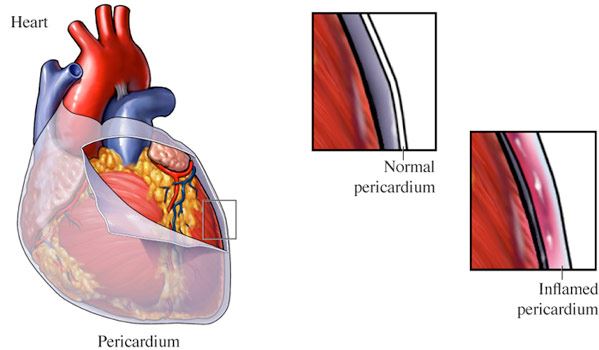Pericarditis
The heart is surrounded by a double-layered sac called the pericardium. Between these two layers, there is a space known as the pericardial cavity. The pericardial cavity normally contains a small amount of pericardial fluid. This fluid prevents friction between the two layers and helps your heart move easier within the sac. However, if the pericardium is diseased or injured, inflammation can occur. This condition is known as pericarditis. Pericarditis may develop suddenly (acute), gradually (chronic) or it may present itself in patients without remission or in those who’ve recently had early reappearance of symptoms within 4 to 6 weeks after a documented first episode of pericarditis (incessant).

Medical Illustration Copyright © 2019 Nucleus Medical Media, All rights reserved.
Causes of Pericarditis
The cause of pericarditis is often unknown, though viral infections are a common cause.
Other conditions that contribute to the development of pericarditis:
- Malignancy “cancerous” spread.
- End-Stage Renal Disease: A condition in which your kidneys have stopped working well and your body retains fluid.
- Tuberculosis: Potentially serious infectious bacterial disease that mainly affects the lungs.
- HIV/AIDS
- Viral, bacterial, fungal or parasitic infections.
- Autoimmune Disease: A condition in which your immune system mistakenly attacks your body (e.g. lupus, rheumatoid arthritis and scleroderma).
- A previous heart attack and/or heart surgery.
- Injuries from accidents or radiation therapy.
- Certain medications that treat seizures, blood clots and arrhythmias.
Symptoms of Pericarditis
Common symptoms of pericarditis include:
- Sharp, piercing chest pain over the center or left side of the chest that last for hours and does not get better when you rest.
- Shortness of breath
- Heart palpitations
- Lightheadedness/Fainting
- Confused or impaired thinking
- Nausea and/or vomiting
- Decreased urine output
- Anxiety
- Swelling of the legs or abdomen
- Muscle aches
Diagnosis of Pericarditis
The clinical diagnosis of pericarditis is usually based on the patient’s medical history and physical examination findings. As part of your initial physical evaluation, your doctor will also check your heart for heart murmurs. Heart murmurs particularly made when the pericardial layers rub against each other. After that, your doctor may recommend diagnostic tests. Some of the diagnostic tests and procedures include:
Treatment of Pericarditis
Treatment for pericarditis depends on the cause as well as the severity. The majority of cases are self-limiting and get better on their own without treatment. Treatment options include:
Medications
- Antibiotics will help treat disease caused by bacteria.
- Anti-Inflammatory medications will help reduce inflammation and relief pain.
